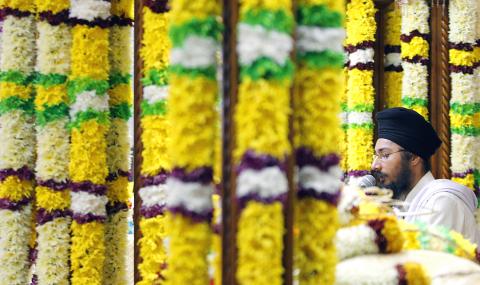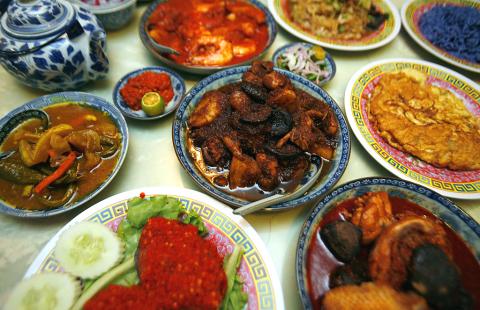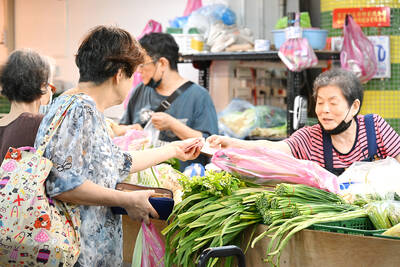On the tranquil grounds of the Cheng Hoon Teng Temple, Malaysia’s oldest Taoist house of worship, late afternoon visitors bowed and offered burning wands of incense to a gilded statue of the Goddess of Mercy, the deity for whom the temple was founded in the 1600s. Tourists quietly watched or focused cameras on the structure’s ornate, figurine-covered roof.
The placidity was interrupted by the muezzin’s call from the nearby Kampung Kling Mosque, an amalgam of Corinthian columns, Portuguese tiles and Hindu carvings, built by Indian Muslims in 1748. And down the street at the 230-year-old Sri Poyyatha Vinayagar Moorthi Temple, the country’s oldest Hindu temple, bare-chested and barefoot men in pastel-hued sarongs and garlands made of yellow blooms gathered to pray.
It was another seemingly sleepy afternoon in Malacca, Malaysia’s oldest city, just two hours south of Kuala Lumpur and about four hours northwest of Singapore. But underneath that sleepiness, its foundation of vibrant multiculturalism, which dates back centuries, is very much alive and increasingly accessible, as it welcomes a handful of hotels and millions of international visitors a year.

Photo: Reuters
“I just love Malacca — its laid-back, slow pace of life and the history in the buildings, the people, the culture,” said a local resident, Colin Goh, 66, at Cheng Hoon, surrounded by a pair of red-and-gold sedan chairs and black-and-white photos that chronicled decades of the temple’s religious festivals. “Everything you touch that is not new is old.”
With his mix of Portuguese, Dutch, Chinese and “God only knows what else” heritage, Goh, a retired civil servant who now manages 8 Heeren Street, a restored 18th-century Dutch shophouse, embodies the city’s colonial past. Founded around 1400 by a Malay-Hindu prince, Malacca, within a century, became Southeast Asia’s most important trading port, luring an international cast of colonialists and merchants seeking a piece of the region’s lucrative spice trade.
The hub of Malacca’s civic colonial sites is Dutch Square — also called Red Square because of the color of its buildings — where tourists pose in front of the century-old Queen Victoria Fountain and trishaws festooned with plastic flowers gather. Nearby are the ruins of the A’Famosa fort, one of Asia’s oldest European-built structures, erected by the Portuguese 500 years ago, and the imposing Stadthuys, or town hall, built by the Dutch in 1650 and later painted salmon red by the British, Malacca’s last foreign rulers, whose reign lasted until 1957.

On the west side of the Malacca River, which flanks the square, along the old center’s narrow, atmospheric streets, are hundreds of lantern-hung shophouses, some distinctly Chinese in style, others bearing geometric Art Deco trademarks, and grand residences with ornately tiled stoops built by wealthy families of the past. For centuries, these streets served as the town’s commercial and residential center.
Malacca’s eclectic charm, with some help from a UNESCO World Heritage designation in 2008 and its reputation as one of Malaysia’s most exciting culinary destinations, has resulted in a steady growth in tourism. Last year 12 million visitors came, an increase of over 17 percent from 2010, according to a state tourism committee.
While some heritage buildings are still occupied by generations-old family businesses — silversmiths, watchmakers, dim sum purveyors — others have newer identities. At Temple Street, a shop run by a local artist, watercolors and hand-painted tiles depict idyllic street scenes. In another building, Nancy’s Kitchen, a no-frills restaurant known for its local Nyonya cuisine, sells addictive delicacies like buttery pineapple tarts and onde-onde, glutinous rice balls filled with Malacca’s famous palm sugar, known as gula Melaka, and covered in fresh coconut.

Photo: Reuters
The Baba Nyonya Heritage Museum, in a grand, preserved residence on Heeren Street (officially known as Jalan Tun Tan Cheng Lock), pays tribute to Peranakans, a group of wealthy, sophisticated families that arose from the intermarrying of Babas, or Chinese traders, and Nyonyas, or local residents.
The Peranakans forged a distinct East-meets-West culture that represents much of what makes Malacca so fascinating: A racial and religious multiculturalism that’s been cultivated and honored for centuries.
This rich cultural heritage is also being celebrated in new lodging options. In 2009, a 100-year-old residential property down the street was converted into the 14-room Courtyard@Heeren hotel, which blends era-appropriate furnishings with modern amenities. At the Snail House nearby, a charming French-Malaccan couple, Serge and K.C. Jardin, rent rooms in their carefully restored century-old home, with an open courtyard, a grand spiral staircase and high ceilings, offering travelers the chance to appreciate the nuances of Peranakan architecture.
“When you’re inside, you feel as if you’re in the presence of a wealthy Baba,” Jardin said. “And though you’re in the city center, it’s so quiet you forget where you are.”
Josephine Chua, a self-described “busybody housewife,” history buff and proponent of Malacca’s historic preservation, agreed.
“This place has been built on harmony since the 15th century,” she said.
Chua, 55, traces her local roots back nine generations, to 1765, when one of her paternal ancestors migrated from Fujian, China.
“The religions have coexisted side by side for centuries — that’s what makes us so unique and the town so great to live in,” she said. This is a particularly telling statement in modern-day Malaysia, whose Muslim, Malay-majority government has been criticized for exploiting ethnic divisions for the sake of political gain. “We don’t ask each other about one’s race and religion, but what we do always ask each other is, ‘Have you eaten?”’
Where one has dined is not a question to be taken lightly in a city of restaurants serving home-cooked dishes, many of which have been passed down through generations. At Aunty Lee, a grandmotherly spot with lace curtains and pastel walls just a short drive from the historic center, septuagenarian chefs cook mouthwatering renditions of classic Nyonya dishes — chicken stewed with earthy, smoky keluak nuts; a fluffy omelet flavored with dried shrimp and chili; and cendol, a shaved ice dessert topped with coconut milk and gula Melaka.
At Donald & Lily’s, locals and tourists alike snack on Nyonya laksa, a creamy and piquant concoction of fresh coconut milk, sliced fish cakes, cockles, crunchy bean sprouts, and pounded galangal, garlic, lemon grass and shrimp paste. The retired proprietor, Donald Tan, who started selling laksa from a trishaw 30 years ago, now offers food in two rooms attached to his majestic Peranakan house. He is happy to give inquisitive visitors a peek into the home, which is jammed with laughing Buddha statues, antiques and old family photos.
A few streets away, at Teo Soon Loong Chan restaurant, the energetic Tan brothers sweat over a pair of woks, producing ridiculously tasty southeastern Chinese teochew fare, like handmade pillowy, deep-fried tofu cubes with minced pork, and platters of steamed pomfret, a local fish, served with shiitakes and cilantro. The restaurant, in a 120-year-old building whose low ceilings are hung with a pair of fraying chandeliers, was once a liquor store run by the brothers’ 85-year-old father, who escaped to Malacca in the 1930s when the Japanese invaded China.
Though authentic culture is easy to find in the city, residents like Chua and Goh worry about its future. The old center is now home to a recently opened Hard Rock Cafe, and many historic buildings have fallen into disrepair or been transformed into conventional souvenir shops and hostels, with no government financing to protect them.
Perhaps the most glaring example is Jonker Street, officially called Jalan Hang Jebat. Once known for its antiques shops, the strip now draws tour groups trawling stores stocked with Birkenstock knockoffs, batik linens and cheeky T-shirts with sayings like, “If YouTube MySpace, I’ll Google Your Yahoo.” It’s particularly raucous on weekends, when a food and retail night market takes over.
Still, what captivated explorers and entrepreneurs centuries ago never seems far away, whether it’s during a contemplative moment in a crumbling church or a stroll along the old town’s back streets and its fragrant Chinese medicine shops. Or while you are sipping a steaming cup of tea during a downpour at Zheng He Tea House, a hidden spot two blocks from Jonker Street. “Once you step into Malacca, you can feel the positive energy,” said Pak Siew Yong, the teahouse’s friendly owner. “Foreigners, once they come here, they don’t want to go home.”

“Why does Taiwan identity decline?”a group of researchers lead by University of Nevada political scientist Austin Wang (王宏恩) asked in a recent paper. After all, it is not difficult to explain the rise in Taiwanese identity after the early 1990s. But no model predicted its decline during the 2016-2018 period, they say. After testing various alternative explanations, Wang et al argue that the fall-off in Taiwanese identity during that period is related to voter hedging based on the performance of the Democratic Progressive Party (DPP). Since the DPP is perceived as the guardian of Taiwan identity, when it performs well,

The Taiwan People’s Party (TPP) on May 18 held a rally in Taichung to mark the anniversary of President William Lai’s (賴清德) inauguration on May 20. The title of the rally could be loosely translated to “May 18 recall fraudulent goods” (518退貨ㄌㄨㄚˋ!). Unlike in English, where the terms are the same, “recall” (退貨) in this context refers to product recalls due to damaged, defective or fraudulent merchandise, not the political recalls (罷免) currently dominating the headlines. I attended the rally to determine if the impression was correct that the TPP under party Chairman Huang Kuo-Chang (黃國昌) had little of a

At Computex 2025, Nvidia CEO Jensen Huang (黃仁勳) urged the government to subsidize AI. “All schools in Taiwan must integrate AI into their curricula,” he declared. A few months earlier, he said, “If I were a student today, I’d immediately start using tools like ChatGPT, Gemini Pro and Grok to learn, write and accelerate my thinking.” Huang sees the AI-bullet train leaving the station. And as one of its drivers, he’s worried about youth not getting on board — bad for their careers, and bad for his workforce. As a semiconductor supply-chain powerhouse and AI hub wannabe, Taiwan is seeing

Jade Mountain (玉山) — Taiwan’s highest peak — is the ultimate goal for those attempting a through-hike of the Mountains to Sea National Greenway (山海圳國家綠道), and that’s precisely where we’re headed in this final installment of a quartet of articles covering the Greenway. Picking up the trail at the Tsou tribal villages of Dabang and Tefuye, it’s worth stocking up on provisions before setting off, since — aside from the scant offerings available on the mountain’s Dongpu Lodge (東埔山莊) and Paiyun Lodge’s (排雲山莊) meal service — there’s nowhere to get food from here on out. TEFUYE HISTORIC TRAIL The journey recommences with